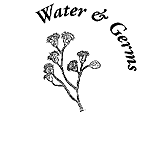
Introduction
1. What are germs?
2. Getting germs
3. Germ environment
4. Germ travel
5. Symptoms
6. Water's role
7. Water suppliers
8. Rules
9. Conclusion
Diseases & pathogens
Note on E. coli
| ON THIS PAGE: | Keeping
pollutants out of source waters Water treatment removes pollutants Disinfection kills bacteria |
So, since microbes are everywhere, what are the protective measures we can take? We have already begun to discuss this in general terms, but let us consider a specific series of barriers that water suppliers can put in place to preclude the spread of disease through drinking water.
Keeping
pollutants out of source waters
The first barrier is preventive. Minimizing
contamination of source waters is called source protection. At Quabbin
and Wachusett Reservoirs, human contact with the water is carefully limited.
Because people aren't allowed to swim in the reservoir, or camp on its
shores, exposure of the water to human pathogens is reduced. If the nearest
homes or neighborhoods are some distance away, the chance of material
from a leaking sewer line or a malfunctioning septic system reaching the
reservoir while still viable (able to cause infection) is greatly reduced.
Animal populations are monitored, and bird populations are encouraged
not to congregate near any intake structure. In surface water systems,
another term for source protection is watershed management, and it is
a high priority of MWRA and the Metropolitan District Commission, who
manage the reservoirs.
Water
treatment removes pollutants
The
next barriers against microbes in surface water are sedimentation
(often called clarification) and filtration.
All river sources and many reservoirs need clarification and filtration.
Only the cleanest, best protected sources are able to skip these processes.
In clarification tanks, a simple chemical is often added to encourage small particles, whether soil or vegetation or micoorganisms, to clump together. Then they either settle at the bottom or float to the top, leaving the water much cleaner. MWRA does not have clarification tanks now, though we may in the future. Our water resides so long in Quabbin and Wachusett Reservoirs that natural sedimentation cleans the water effectively.
In filtration systems, water seeps through layers of sand or other materials, imitating nature's filtration of groundwater. If a filter has small enough pores, water will seep through, but solid particles, including microorganisms, will be screened out. At this time, MWRA water from Quabbin and Wachusett Reservoirs is not filtered, though that too may change in years to come.
All these
barriers have costs. Water suppliers must consider the quality of both
their source and treated ("finished") water, as well as cost, to decide
which form of protection is best.
 |
See
the kinds of germs we're talking about |
|